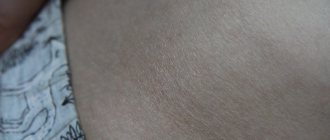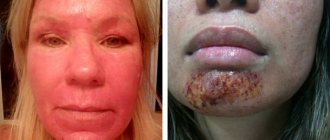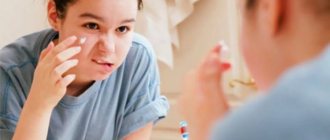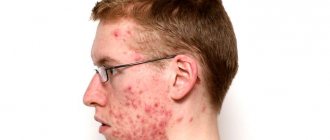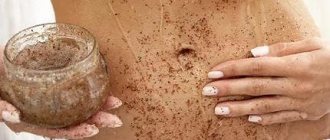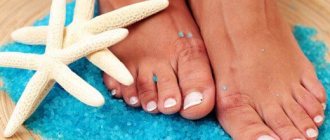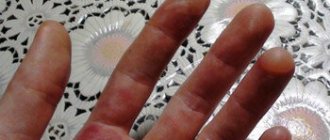Causes: domestic injury or disease?
Carefully inspect the surface of the redness. There is no need to see a doctor if it is caused by:
- shoe friction;
- improperly performed leg depilation;
- callus;
- exposure to the sun or wind;
- The cosmetic product for the feet was not suitable;
- bite of a harmless insect (mosquito);
- prickly heat.
Reasons to see a doctor immediately:
- Acute allergic reaction (urticaria).
- Infectious disease (chickenpox, rubella).
- Pityriasis rosea.
- Bite of a dangerous insect (tick, bedbugs).
Reasons why mandatory treatment is required:
- Allergic Vasculitis;
- Varicose veins;
- Diabetes;
- Hemangioma.
- Fungus on the feet and toes.
- Psoriasis.
When the source of the problem is determined, the correct treatment is prescribed under the supervision of a dermatologist or therapist.
Problems appearing on the toenails
Brown spots on the toenails are caused by wearing uncomfortable shoes. The nails are injured, blood circulation is disrupted, which leads to a change in the color of the nail part.
But there will be other causes of dark spots:
- Bruising, which subsequently appears as dark spots;
- Vitamin deficiency, lack of vitamin B 12;
- Kidney failure;
- Heart diseases;
- Bronchitis or lung problems;
- Malignant melanoma;
- Longitudinal, brown stripes on the nail plate indicate pigmentary pathologies;
- If the spot appears on the large nail, around the skin, this may indicate manifestations of psoriasis.
Brownish spots on the nails do not always mean the presence of a disease. Changing the color of the nail plate is associated with improper care of this part of the body.
Allergic diseases
Red spots on the legs indicate an allergic reaction of the body to some factor. The human body works like a clock and, if something is wrong, it gives a signal about it without indicating the source. The allergen must be determined independently or with the help of a doctor.
The causes of an allergic reaction vary:
- Incorrectly selected cosmetic product or drug;
- Contact with a chemical substance (washing powder, toilet cleaner, etc.);
- Nervous tension, severe stress;
- Allergenic product (citrus fruits, honey, chocolate);
- Pets.
Symptoms of an allergic reaction on the feet
The reaction begins immediately upon contact with the allergen or after some time. Spots on the skin of the legs are red, itchy, and irregular in shape. Small blisters may appear on the spots. For a speedy recovery, you will need to remove the allergen and take antihistamines such as Suprastin, Erius, Tavegil. Maintaining foot hygiene is important.
Help with acute allergic reactions
- Call an ambulance.
- Open the window for air access.
- Place the patient on his back on a hard surface.
- Place something soft under your head and turn your head to the side.
- Give an injection (shot) of Suprastin - two milliliters IM.
- All of the above is done quickly, but without fuss.
- If cardiac arrest occurs, perform indirect cardiac massage with artificial pulmonary ventilation (ALV); 15:2.
Symptoms of pathology of the lower extremities
One of the most basic symptoms of the disease is the appearance of subcutaneous nodes, which become more dense over time. In the places where they appear, the skin becomes red; due to the swelling of the tissues, the borders do not have pronounced outlines. Compacted nodes are painful, especially when palpated.
They can be localized in the legs, buttocks, face and forearm. The lesions will be either single unilateral or symmetrical bilateral.
In addition to the immediate signs of the disease, the patient may experience symptoms:
- General malaise;
- Increased body temperature to low-grade levels;
- Chills;
- Pain in the joints;
- Irritability;
- Headache.
All these indicators taken together indicate the development of erythema nodosum in a person.
Psoriasis
This is the most common disease, as the causes of its occurrence are various:
- allergy;
- taking medications for a long time;
- breakdown;
- immunodeficiency;
- acclimatization, etc.
Most often, psoriasis appears on the legs. You can recognize it if you scratch the red spot - it will become glossy and covered with droplets of blood.
The dermatologist prescribes ointments to relieve inflammation and peeling, glucocorticoid and corticosteroid drugs. A strict diet and a vitamin-mineral complex for immunity are prescribed. The disease is chronic. To prevent psoriasis from returning for a long time, you need to eat right and lead a healthy lifestyle.
Preventive measures
By adhering to certain rules, the likelihood of pigmentation occurring in the leg area is reduced to zero.
- Do not stay in the hot rays of the scorching sun for a long time.
- Protect your legs from direct sunlight with trousers; thick fabric can shield the body.
- Drink as much fluid as possible to prevent dehydration.
- Add as many fruits, vegetables and herbs (parsley, celery, dill) to your diet.
- When preparing breakfast, lunch or dinner, do not forget about vitamin E, which is abundant in butter.
- Buy cosmetics with a whitening effect and high quality, do not skimp on the price.
- For pigmentation, apply masks and cream compositions to the skin in winter (late autumn, winter).
- When you decide to sunbathe on the beach, do not forget to use sunscreen. It will protect the skin from the occurrence of pigmented, brown spots.
- The skin, which was previously subject to pigmentation, becomes sensitive. Protect your feet from exposure to ultraviolet radiation.
Doctor: Olga Shishkina ✓ Article checked by doctor
Infectious diseases
Pityriasis rosea
An infectious disease, but not dangerous. Infection occurs due to weakened immunity. Red spots with clear boundaries of different sizes appear on the skin of the legs. The spots are slightly raised, flaky and itchy. In a short time they spread throughout the body. Weakness and low body temperature are observed.
Treatment is prescribed after examination by a dermatologist, who determines the exact type of lichen. Symptoms go away after six weeks without treatment. If the spots cause discomfort, antihistamines are taken. It is mandatory to take vitamins to boost immunity. Do not allow lichen lesions to come into contact with water. A person who has had shingles acquires immunity for life.
Fungus on feet
Red spots on the feet and between the toes may indicate athlete's foot. Redness on the feet itches and peels. Only a dermatologist can determine foot fungus using bacteriological culture; he will prescribe antifungal drugs (onycholactics, gels, creams and tablets).
Diabetes
In people with diabetes, the body's immune system suffers. Therefore, skin infections and dermopathy occur. The formation of red spots with blisters on the lower leg is associated with damage to the blood vessels of the legs; treatment is not required. Infectious diseases cause swelling, inflammation and severe redness of the skin. Skin diseases can be prevented by following a diabetic diet, taking medications, and controlling blood sugar levels.
Hemangioma
A tumor on the skin is not dangerous. It looks like a red formation, blue ones are less common. Spots with uneven edges, different shapes and sizes. Appear on the legs and feet. Gradually they become smaller and whiter until they disappear. If this does not happen after a month, the spot is removed using a laser or surgery.
Varicose veins of the legs
This is a disease of weak blood vessel walls in the legs. Red and blue spots similar to stars appear on the calves. At first they don't bother you, but then they itch. Heaviness begins, pain in the legs while walking, shortness of breath.
Varicose veins are inherited from mothers and grandmothers. More often women suffer from it. The provoking factor is wearing high-heeled shoes, being overweight, and frequently squeezing the veins in a sitting position. Treatment is prescribed only by a doctor. When the form is not advanced, compression stockings, tights, therapeutic massage, taking pills, using ointments and gels to strengthen blood vessels, and medications that thin the blood in the veins are used. In advanced forms, varicose veins are treated surgically and sclerotherapy.
Don't ignore any changes, even if they don't bother you. Redness on the legs indicates the above diseases. The main thing is to understand the level of danger in time. Do not self-medicate under any circumstances. Be sure to consult a dermatologist or therapist.
Erythema nodosum on the legs, modern treatment
Before starting to fight the disease, the doctor must establish the cause that triggered the development of erythema nodosum on the legs. Because any complex treatment always gives more effective results than simply removing symptoms.
If the disease was caused by the presence of some kind of infection in the body, then drugs of the antiviral, antibacterial or antifungal class are prescribed.
When a patient encounters this disease for the first time, specialists usually prescribe medications:
- Antihistamines (tavegil, suprastin, cetirizine);
- Non-steroidal anti-inflammatory drugs (nimesulide, diclofenac);
- Aminoquinoline drugs and corticosteroids are prescribed for prolonged forms of the disease.
Physiotherapy has an effective effect:
- Magnetotherapy;
- Ural Federal District;
- Laser therapy;
- Phonophoresis.
Practitioners do not deny the possibility of using traditional medicine; treatment is carried out locally. More often, compresses and lotions are used on the affected areas of the body.
Famous recipes:
- Herbal decoction of oak bark, black elderberry, raspberry leaves, linden flowers, willow bark and walnut fruits;
- A decoction of plantain leaves, mint and birch buds;
- Dry arnica root ointment.
The healing process is the disappearance of red spots and the skin acquiring a natural shade of color.
Types of age spots
Dark spots
A peculiar brown tint to the skin is given by the pigment melanin, which is normally present in every person. Due to hereditary predisposition, external influences or pathologies of internal organs, excess melanin production can be observed, as a result of which the skin color may change to white, yellow or dark brown. This phenomenon is called hyperpigmentation.
In addition to the lower leg, pigmentation can appear on the arms, stomach, back and face, not only in adults, but also in children, including infants.
Pigment spots are usually divided into the following types:
- Freckles are small round spots that are located mainly on open areas of the skin - the chest, neck, face, arms and, in rare cases, legs. Such dots are formed as a result of exposure of the skin to direct sunlight and appear more often in people with fair skin.
- Moles. They occur in almost all people as they grow older under the influence of ultraviolet radiation, hormones and other factors.
- Lentigines are dark brown or brown spots on the skin, formed as a result of pathological processes in the body. The main reasons for their appearance are diseases of the digestive system, stomach or duodenal ulcers, and cancerous tumors. They begin to form, as a rule, in infancy, gradually increasing in size and acquiring a more saturated shade. The skin where they formed, usually keratinized, begins to peel off, and slight itching is possible. Ultraviolet radiation is considered a provocateur.
- Chloasma is dark, almost black spots on the arms, legs, face, abdomen and near the nipples. The reason for the appearance of such pigmentation is considered to be excessive accumulation of melanin in one place, resulting in the development of spots with well-defined boundaries.
The formation of dark spots on the legs can be caused by pregnancy and individual characteristics of the epidermis. But in addition to harmless factors, the cause can be serious diseases: tuberculosis, malignant tumor, damage to the body by worms or malaria.

